2011 HYUNDAI TUCSON tow
[x] Cancel search: towPage 283 of 382
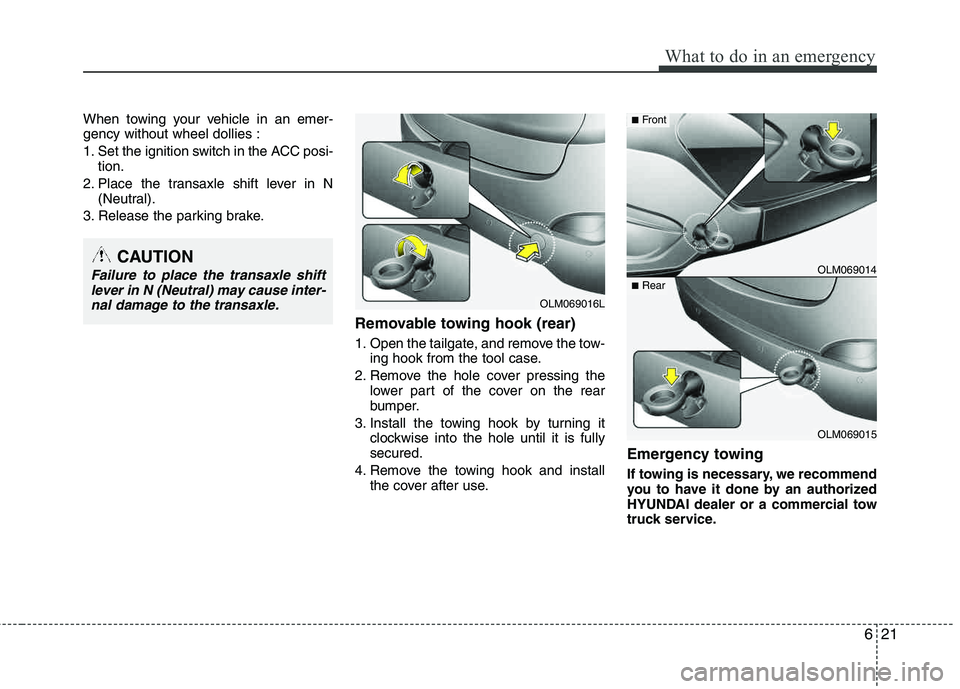
621
What to do in an emergency
When towing your vehicle in an emer- gency without wheel dollies :
1. Set the ignition switch in the ACC posi-tion.
2. Place the transaxle shift lever in N (Neutral).
3. Release the parking brake.
Removable towing hook (rear)
1. Open the tailgate, and remove the tow- ing hook from the tool case.
2. Remove the hole cover pressing the lower part of the cover on the rear
bumper.
3. Install the towing hook by turning it clockwise into the hole until it is fullysecured.
4. Remove the towing hook and install the cover after use.
Emergency towing
If towing is necessary, we recommend
you to have it done by an authorized
HYUNDAI dealer or a commercial tow
truck service.
CAUTION
Failure to place the transaxle shift
lever in N (Neutral) may cause inter-
nal damage to the transaxle.
OLM069016L
OLM069014
OLM069015
■ Front
■Rear
Page 284 of 382
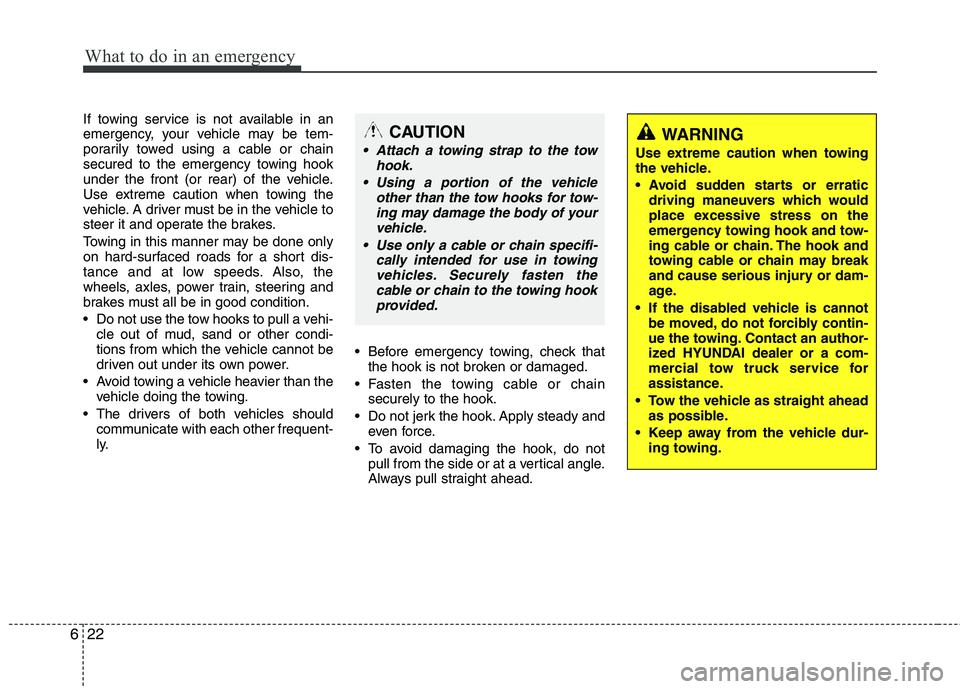
What to do in an emergency
22
6
WARNING
Use extreme caution when towing
the vehicle.
driving maneuvers which would
place excessive stress on the
emergency towing hook and tow-
ing cable or chain. The hook and
towing cable or chain may break
and cause serious injury or dam-
age.
If the disabled vehicle is cannot be moved, do not forcibly contin-
ue the towing. Contact an author-
ized HYUNDAI dealer or a com-
mercial tow truck service for
assistance.
Tow the vehicle as straight ahead as possible.
Keep away from the vehicle dur- ing towing.
If towing service is not available in an
emergency, your vehicle may be tem-
porarily towed using a cable or chain
secured to the emergency towing hook
under the front (or rear) of the vehicle.
Use extreme caution when towing the
vehicle. A driver must be in the vehicle to
steer it and operate the brakes.
Towing in this manner may be done only
on hard-surfaced roads for a short dis-
tance and at low speeds. Also, the
wheels, axles, power train, steering and
brakes must all be in good condition.
Do not use the tow hooks to pull a vehi-cle out of mud, sand or other condi-
tions from which the vehicle cannot be
driven out under its own power.
Avoid towing a vehicle heavier than the vehicle doing the towing.
The drivers of both vehicles should communicate with each other frequent-
ly. Before emergency towing, check that
the hook is not broken or damaged.
Fasten the towing cable or chain securely to the hook.
Do not jerk the hook. Apply steady and even force.
To avoid damaging the hook, do not pull from the side or at a vertical angle.
Always pull straight ahead.CAUTION
Attach a towing strap to the tow
hook.
Using a portion of the vehicle other than the tow hooks for tow-ing may damage the body of yourvehicle.
Use only a cable or chain specifi- cally intended for use in towingvehicles. Securely fasten thecable or chain to the towing hook
provided.
Page 285 of 382

623
What to do in an emergency
Use a towing strap less than 16 feet (5m) long. Attach a white or red cloth (about 12 inches (30 cm) wide) in the
middle of the strap for easy visibility.
Drive carefully so that the towing strap is not loosened during towing.
Emergency towing precautions
Turn the ignition switch to ACC so the
steering wheel isn’t locked.
Place the transaxle shift lever in N (Neutral).
Release the parking bake.
Press the brake pedal with more force than normal since you will have
reduced brake performance.
More steering effort will be required because the power steering system
will be disabled.
If you are driving down a long hill, the brakes may overheat and brake per-
formance will be reduced. Stop often
and let the brakes cool off.
OEN066014
CAUTION - Automatic transaxle
If the car is being towed with all
four wheels on the ground, it canbe towed only from the front. Be
sure that the transaxle is in neu-tral. Be sure the steering isunlocked by placing the ignition switch in the ACC position. A
driver must be in the towed vehi- cle to operate the steering andbrakes.
To avoid serious damage to the automatic transaxle, limit thevehicle speed to 15 km/h (10 mph)and drive less than 1.5 km (1
mile) when towing.
Before towing, check the auto- matic transaxle for fluid leaks
under your vehicle. If the auto-matic transaxle fluid is leaking,flatbed equipment or a towingdolly must be used.
Page 286 of 382
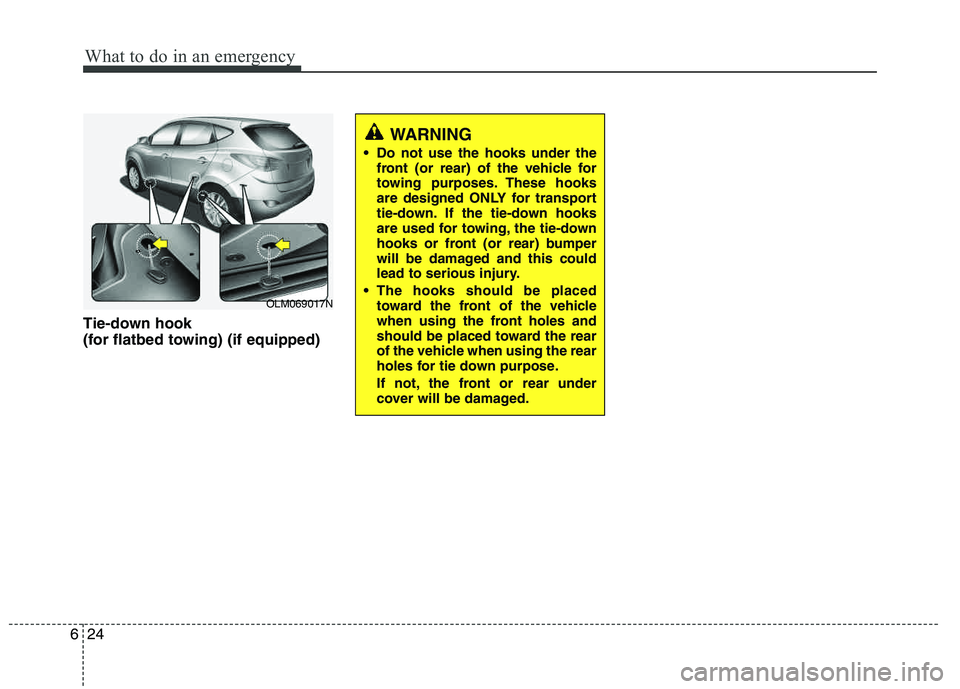
What to do in an emergency
24
6
Tie-down hook
(for flatbed towing) (if equipped)
WARNING
Do not use the hooks under the front (or rear) of the vehicle for
towing purposes. These hooks
are designed ONLY for transport
tie-down. If the tie-down hooks
are used for towing, the tie-down
hooks or front (or rear) bumper
will be damaged and this could
lead to serious injury.
The hooks should be placed toward the front of the vehicle
when using the front holes and
should be placed toward the rear
of the vehicle when using the rear
holes for tie down purpose.
If not, the front or rear under
cover will be damaged.
OLM069017N
Page 303 of 382

717
Maintenance
MAINTENANCE UNDER SEVERE USAGE CONDITIONS
SEVERE DRIVING CONDITIONS
A - Repeatedly driving short distance of less than 5 miles (8 km) in normal tem-perature or less than 10 miles (16 km) in freezing temperature
B - Extensive engine idling or low speed driving for long distances
C - Driving on rough, dusty, muddy, unpaved, graveled or salt- spread roads
D - Driving in areas using salt or other corrosive materials or in very cold weather
E - Driving in sandy areas F - Driving in heavy traffic area over 90°F (32°C)
G - Driving on uphill, downhill, or mountain road
H - Towing a Trailer, or using a camper, or roof rack
I - Driving as a patrol car, taxi, other commercial use or vehicle towing
J - Driving over 106 mph (170 km/h)
K - Frequently driving in stop-and-go conditions
The following items must be serviced more frequently on cars normally used under severe driving conditions. Refer to the chart
below for the appropriate maintenance intervals.
R : Replace I : Inspect and, after inspection, clean, adjust, repair or replace if necessary
MAINTENANCE ITEMMAINTENANCE
OPERATIONMAINTENANCE INTERVALSDRIVING CONDITION
ENGINE OIL AND FILTERREVERY 3,750 MILES (6,000 KM) OR 6 MONTHSA, B, C, D, E, F, G, H, I, K
AIR CLEANER FILTERRMORE FREQUENTLYC, E
SPARK PLUGSRMORE FREQUENTLYB, H
AUTOMATIC TRANSAXLE FLUIDREVERY 60,000 MILES (96,000 KM) A, C, E, F, G, I
MANUAL TRANSAXLE FLUIDREVERY 75,000 MILES (120,000 KM) A, C, E, F, G, I
FRONT BRAKE DISC/PADS, CALIPERSIMORE FREQUENTLYC, D, G, H
REAR BRAKE DISC /PADSIMORE FREQUENTLYC, D, G, H
PARKING BRAKEIMORE FREQUENTLYC, D, G, H
STEERING GEAR BOX, LINKAGE & BOOTS/
LOWER ARM BALL JOINT, UPPER ARM BALL JOINTIMORE FREQUENTLYC, D, E, F, G, H, I
DRIVE SHAFTS AND BOOTSIEVERY 7,500 MILES (12,000 KM) OR 6 MONTHSC, D, E, F, G, H, I, J
TRANSFER CASE OIL (AWD) REVERY 75,000 MILES (120,000 KM)C, D, E, G, H, I, J
REAR AXLE OIL (AWD)REVERY 75,000 MILES (120,000 KM)C, D, E, G, H, I, J
CLIMATE CONTROL AIR FILTER
(FOR EVAPORATOR AND BLOWER UNIT)RMORE FREQUENTLYC, E
PROPELLER SHAFTIEVERY 7,500 MILES (12,000 KM) OR 6 MONTHSC, E
Page 309 of 382
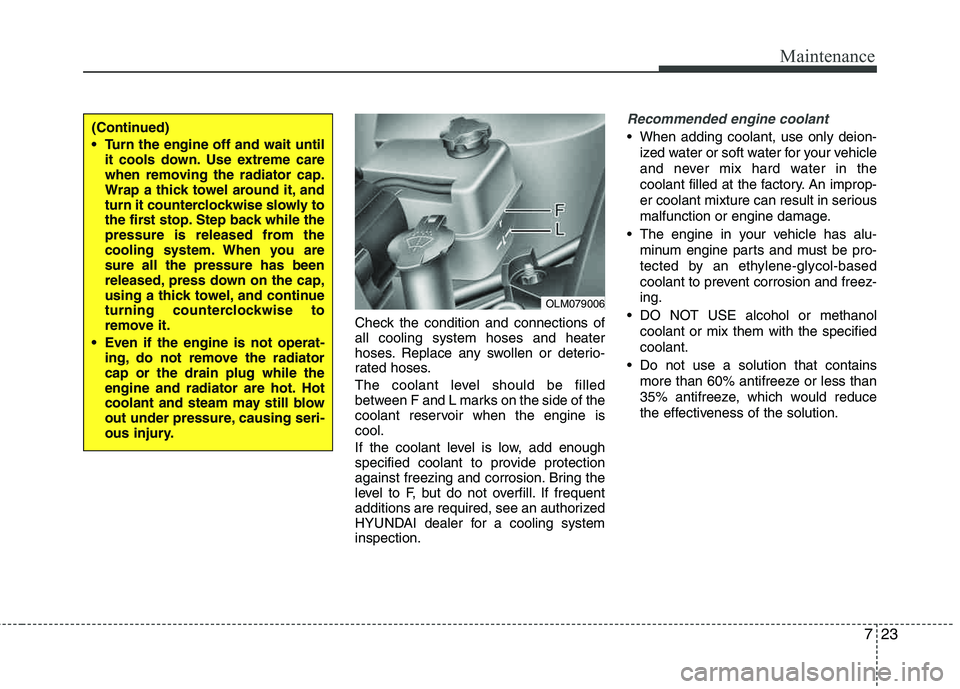
723
Maintenance
Check the condition and connections of all cooling system hoses and heater
hoses. Replace any swollen or deterio-
rated hoses.
The coolant level should be filled
between F and L marks on the side of the
coolant reservoir when the engine iscool.
If the coolant level is low, add enough
specified coolant to provide protection
against freezing and corrosion. Bring the
level to F, but do not overfill. If frequent
additions are required, see an authorized
HYUNDAI dealer for a cooling systeminspection.
Recommended engine coolant
When adding coolant, use only deion-ized water or soft water for your vehicle
and never mix hard water in the
coolant filled at the factory. An improp-
er coolant mixture can result in serious
malfunction or engine damage.
The engine in your vehicle has alu- minum engine parts and must be pro-
tected by an ethylene-glycol-based
coolant to prevent corrosion and freez-ing.
DO NOT USE alcohol or methanol coolant or mix them with the specifiedcoolant.
Do not use a solution that contains more than 60% antifreeze or less than
35% antifreeze, which would reduce
the effectiveness of the solution.
OLM079006
(Continued)
Turn the engine off and wait untilit cools down. Use extreme care
when removing the radiator cap.
Wrap a thick towel around it, and
turn it counterclockwise slowly to
the first stop. Step back while the
pressure is released from the
cooling system. When you are sure all the pressure has been
released, press down on the cap,
using a thick towel, and continue
turning counterclockwise to
remove it.
Even if the engine is not operat- ing, do not remove the radiator cap or the drain plug while the
engine and radiator are hot. Hot
coolant and steam may still blow
out under pressure, causing seri-
ous injury.
Page 376 of 382

Index
4I
Defrosting (Windshield) ················································4-77
Digital clock···································································4-85
Dimensions ······································································8-2
Displays, see instrument cluster ····································4-33
Display illumination, see instrument panel illumination···4-34
Door locks········································································4-9 Central door lock switch ·············································4-10
Child-protector rear door lock ·····································4-12
Drinks holders, see cup holders·····································4-83
Driver's air bag·······························································3-49
Driving at night ······························································5-43
Driving in flooded areas ················································5-44
Driving in the rain··························································5-44
Economical operation ····················································5-40
Electronic power steering ·············································4-28
Electronic stability control (ESC) ·································5-29
Emergency starting ··························································6-4 Jump starting ·································································6-4
Push starting ··································································6-5
Emergency tailgate safety release··································4-14
Emergency towing ·························································6-21
Emergency while driving ·················································6-2
Emission control system ················································7-72 Crankcase emission control system·····························7-72
Evaporative emission control (including ORVR) System ·······································································7-72
Exhaust emission control system ································7-73 Engine compartment ················································2-4, 7-2
Engine coolant ·······························································7-22
Engine number ·································································8-7
Engine oil ·······································································7-21
Engine overheats ······························································6-6
Engine temperature gauge ·············································4-35
Engine will not start·························································6-3
Evaporative emission control (including ORVR) System ··
7-72
Exhaust emission control system···································7-73
Explanation of scheduled maintenance items ···············7-18
Exterior care···································································7-66
Exterior features·····························································4-88 Roof rack ·····································································4-88
Flat tire ···········································································6-12 Changing tires······························································6-13
Compact spare tire ·······················································6-18
Jack and tools ······························································6-12
Removing and storing the spare tire····························6-13
Floor mat anchor(s) ·······················································4-85Fluid Brakes/clutch fluid·······················································7-25
Washer fluid·································································7-26
Folding the rear seat ······················································3-13
Four wheel drive (4WD), See all wheel drive (AWD) ··5-17
Front fog light bulb replacement ···································7-61
Front seat adjustment - manual ·······································3-5
Front seat adjustment - power ·········································3-6
EF
Page 381 of 382
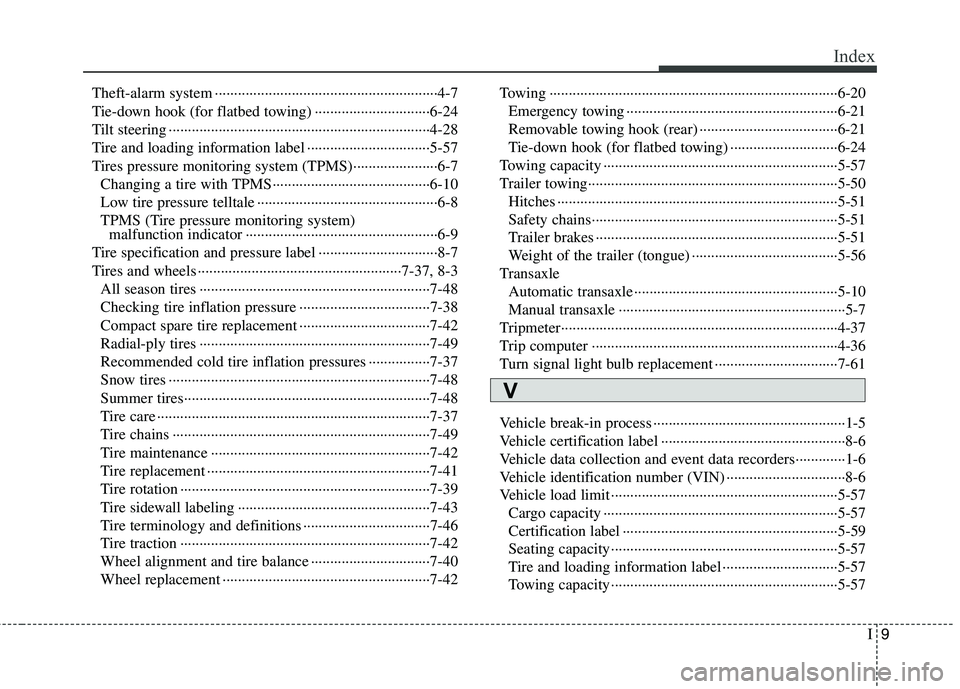
I9
Index
Theft-alarm system ··························································4-7
Tie-down hook (for flatbed towing) ······························6-24
Tilt steering ····································································4-28
Tire and loading information label ································5-57
Tires pressure monitoring system (TPMS)······················6-7Changing a tire with TPMS·········································6-10
Low tire pressure telltale ···············································6-8
TPMS (Tire pressure monitoring system) malfunction indicator ··················································6-9
Tire specification and pressure label ·······························8-7
Tires and wheels ·····················································7-37, 8-3 All season tires ····························································7-48
Checking tire inflation pressure ··································7-38
Compact spare tire replacement ··································7-42
Radial-ply tires ····························································7-49
Recommended cold tire inflation pressures ················7-37
Snow tires ····································································7-48
Summer tires································································7-48
Tire care ·······································································7-37
Tire chains ···································································7-49
Tire maintenance ·························································7-42
Tire replacement ··························································7-41
Tire rotation ·································································7-39
Tire sidewall labeling ··················································7-43
Tire terminology and definitions ·································7-46
Tire traction ·································································7-42
Wheel alignment and tire balance ·······························7-40
Wheel replacement ······················································7-42 Towing ···········································································6-20
Emergency towing ·······················································6-21
Removable towing hook (rear) ····································6-21
Tie-down hook (for flatbed towing) ····························6-24
Towing capacity ·····························································5-57
Trailer towing·································································5-50 Hitches ·········································································5-51
Safety chains································································5-51
Trailer brakes ·······························································5-51
Weight of the trailer (tongue) ······································5-56
Transaxle Automatic transaxle ·····················································5-10
Manual transaxle ···························································5-7
Tripmeter········································································4-37
Trip computer ································································4-36
Turn signal light bulb replacement ································7-61
Vehicle break-in process ··················································1-5
Vehicle certification label ················································8-6
Vehicle data collection and event data recorders·············1-6
Vehicle identification number (VIN) ·······························8-6
Vehicle load limit ···························································5-57 Cargo capacity ·····························································5-57
Certification label ························································5-59
Seating capacity ···························································5-57
Tire and loading information label ······························5-57
Towing capacity···························································5-57
V